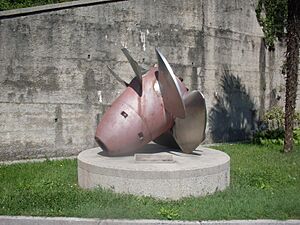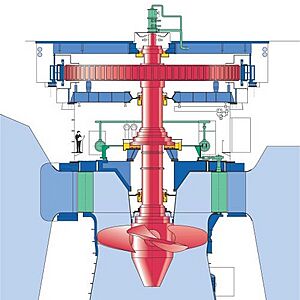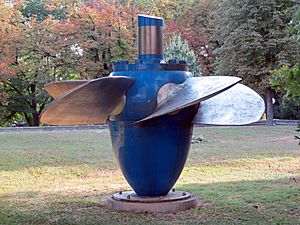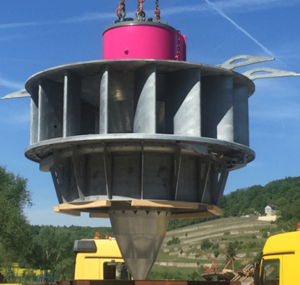Kaplan turbine facts for kids
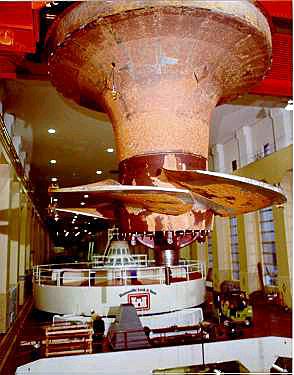
The Kaplan turbine is a special type of water turbine that looks a bit like a ship's propeller. It has blades that can be adjusted, just like a propeller. This turbine was invented in 1913 by an Austrian professor named Viktor Kaplan. He designed it so that both the blades and the water gates (called wicket gates) could adjust automatically. This smart design helps the turbine work very well, even when the amount of water or the water level changes a lot.
The Kaplan turbine was an improved version of an older design called the Francis turbine. Its invention was a big deal because it made it possible to produce electricity efficiently from water that doesn't fall from a very high place. This is known as "low-head" power production. Kaplan turbines can work with water drops (heads) from about 10 to 70 meters (33 to 230 feet). They can produce a lot of power, usually from 5 to 200 megawatts (MW). The spinning part, called the runner, can be huge, from 2 to 11 meters (6.5 to 36 feet) across! These turbines spin at a steady speed, which can be anywhere from 54.5 revolutions per minute (rpm) to 450 rpm.
Today, Kaplan turbines are used all over the world to generate electricity, especially in places with lots of water flow but not very high water drops.
Contents
How the Kaplan Turbine Was Developed
Viktor Kaplan, who lived in a city called Brno (now in the Czech Republic), got his first patent for an adjustable-blade turbine in 1912. A patent is like an official document that says you invented something. But it took about ten more years to make a turbine that could be sold and used widely. Kaplan faced some challenges, especially with a problem called cavitation. This is when tiny bubbles form in the water and can damage the turbine. By 1922, he even stopped his research for a while due to health issues.
In 1919, Kaplan set up a demonstration turbine in a place called Poděbrady. Then, in 1922, a company named Voith introduced a Kaplan turbine that could produce about 800 kilowatts (kW) of power, mainly for use in rivers. The big breakthrough came in 1924 when an 8 MW Kaplan turbine started working in Lilla Edet, Sweden. This success helped Kaplan turbines become popular and used everywhere.
How a Kaplan Turbine Works
The Kaplan turbine is a type of reaction turbine. This means that as water flows through it, its pressure changes, and it gives up its energy. The turbine gets power from both the height of the water (hydrostatic head) and the movement of the water (kinetic energy). Its design combines ideas from two other types of turbines: radial and axial.
Water first enters a spiral-shaped tube that wraps around the turbine's wicket gates. These gates guide the water to flow in a swirling path towards the propeller-shaped runner. This swirling water makes the runner spin.
After passing through the runner, the water flows out through a specially shaped pipe called a draft tube. This tube helps slow down the water and recover some of its leftover energy.
The turbine doesn't have to be at the very bottom of the water flow, as long as the draft tube stays full of water. However, if the turbine is placed too high, it can create a strong suction on the blades, which might lead to cavitation (those damaging bubbles we talked about earlier).
The ability to change the angle of both the wicket gates and the turbine blades allows the Kaplan turbine to work very efficiently, even when the water flow changes. Kaplan turbines are usually over 90% efficient, meaning they turn more than 90% of the water's energy into electricity.
Scientists and engineers are always looking for ways to make these turbines even better. They use computer models to improve efficiency and design new turbines that are safer for fish passing through them.
Because the turbine blades rotate on special bearings that use high-pressure oil, it's very important to keep the oil from leaking into the water. Leaking oil into rivers is bad for the environment and wastes resources.
Where Kaplan Turbines Are Used
Kaplan turbines are used all over the world to make electricity. They are perfect for hydropower sites where the water doesn't fall from a great height but there's a lot of water flowing.
Smaller, less expensive Kaplan-style turbines are also made for individual homes or small communities to produce their own power. These "micro turbines" can work with very small water drops, sometimes as little as 0.3 meters (about 1 foot), if there's enough water flow.
Large Kaplan turbines are custom-designed for each specific location to work as efficiently as possible, often over 90%. They are very expensive to design, build, and install, but they can operate for many decades, producing clean energy.
Recently, Kaplan turbines have even found a new use in offshore wave energy generation, like in projects such as Wave Dragon.
Different Types of Propeller Turbines
The Kaplan turbine is the most common type of propeller turbine, but there are a few other variations:
- Propeller turbines have blades that cannot be adjusted. They are used when the water flow and power needed don't change much. Small ones can make a few hundred watts from just a few feet of water drop. Larger ones can produce over 100 MW. For example, at the La Grande-1 generating station in Canada, 12 propeller turbines make 1368 MW of power.
- Bulb or tubular turbines are built right inside the water delivery pipe. A large, round "bulb" sits in the middle of the pipe and holds the generator, wicket gates, and the runner. These turbines are fully axial, meaning water flows straight through them, unlike Kaplan turbines which have radial wicket gates.
- Pit turbines are like bulb turbines but they have a gearbox. This allows them to use a smaller generator and a smaller bulb.
- Straflo turbines are axial turbines where the generator is placed outside the water channel. It's connected to the outer edge of the runner.
- S-turbines also place the generator outside the water channel, so they don't need a bulb housing. They do this by having a bend in the water channel and a shaft connecting the runner to the generator.
- The VLH turbine (Very Low Head) is an open-flow Kaplan-style turbine that's tilted at an angle to the water flow. It's very large (over 3.55 meters in diameter) and spins slowly. It uses a special generator directly connected to the shaft and is very safe for fish, with less than 5% mortality.
- The DIVE-Turbine is a vertical propeller turbine that can adjust both its wicket gates and its speed. It can produce up to 4 MW of power with efficiency similar to standard Kaplan turbines. Because of its fixed-blade propeller design, it's also considered friendly to fish.
- Tyson turbines are fixed propeller turbines designed to be placed in a fast-flowing river. They can be permanently anchored to the riverbed or attached to a boat or barge.
Images for kids
See also
- Banki turbine
- Carbon offsets and credits
- Carbon Tax
- Draft tube
- Francis turbine
- Gorlov helical turbine
- Hydroelectricity
- Hydropower
- Pelton wheel
- Screw turbine
- Sensor fish, a device used to study the impact of fish
travelling through the Francis and Kaplan turbines - Three-dimensional losses and correlation in turbomachinery
- Turbine
- Water turbine


